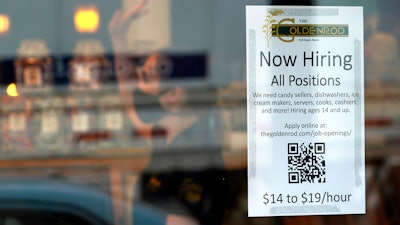
WASHINGTON (AP) — America's employers slowed their hiring in September but still added 263,000 jobs, a solid figure that will likely keep the Federal Reserve on pace to keep raising interest rates aggressively to fight persistently high inflation.
Friday's government report showed that hiring fell from 315,000 in August to the weakest monthly gain since April 2021. The unemployment rate fell from 3.7% to 3.5%, matching a half-century low.
The Fed is hoping that slower job growth would mean less pressure on employers to raise pay and pass those costs on to their customers through price increases — a recipe for high inflation. But September's pace of hiring was likely too robust to satisfy the central bank's inflation fighters.
In September, hourly wages rose 5% from a year earlier, the slowest year-over-year pace since December but still hotter than the Fed would want. The proportion of Americans who either have a job or are looking for one slipped slightly, a disappointment for those hoping that more people would enter the labor force and help ease worker shortages and upward pressure on wages.
The jobs report "was still likely too strong to allow (Fed) policymakers much breathing room," said Matt Peron, director of research at Janus Henderson Investors.
Likewise, Rubeela Farooqi, chief U.S. economist at High Frequency Economics, said she didn't expect September's softer jobs and wage numbers to stop the Fed from raising its benchmark short-term rate in November by an unusually large three-quarters of a point for a fourth consecutive time — and by an additional half-point in December.
Last month, restaurants and bars added 60,000 jobs, as did healthcare companies. State and local governments cut 27,000 jobs. Retailers, transportation and warehouse companies reduced employment modestly.
The public anxiety that has arisen over high prices and the prospect of a recession is carrying political consequences as President Joe Biden's Democratic Party struggles to maintain control of Congress in November's midterm elections.
In its epic battle to rein in inflation, the Fed has raised its benchmark interest rate five times this year. It is aiming to slow economic growth enough to reduce annual price increases back toward its 2% target.
It has a long way to go. In August, one key measure of year-over-year inflation, the consumer price index, amounted to 8.3%. And for now, consumer spending — the primary driver of the U.S. economy — is showing resilience. In August, consumers spent a bit more than in July, a sign that the economy was holding up despite rising borrowing rates, violent swings in the stock market and inflated prices for food, rent and other essentials.
Fed Chair Jerome Powell has warned bluntly that the inflation fight will "bring some pain," notably in the form of layoffs and higher unemployment. Some economists remain hopeful that despite the persistent inflation pressures, the Fed will still manage to achieve a so-called soft landing: Slowing growth enough to tame inflation, without going so far as to tip the economy into recession.
It's a notoriously difficult task. And the Fed is trying to accomplish it at a perilous time. The global economy, weakened by food shortages and surging energy prices resulting from Russia's war against Ukraine, may be on the brink of recession. Kristalina Georgieva, managing director of the International Monetary Fund, warned Thursday that the IMF is downgrading its estimates for world economic growth by $4 trillion through 2026 and that "things are more likely to get worse before it gets better.''
Powell and his colleagues on the Fed's policymaking committee want to see signs that the abundance of available jobs — there's currently an average of 1.7 openings for every unemployed American — will steadily decline. Some encouraging news came this week, when the Labor Department reported that job openings fell by 1.1 million in August to 10.1 million, the fewest since June 2021.
On the other hand, by any standard of history, openings remain extraordinarily high: In records dating to 2000, they had never topped 10 million in a month until last year.
Friday's report underscored how resilient the job market remains.
"The U.S. labor market continues to decelerate, but there are no signs that it's stalling out,'' said Nick Bunker, head of economic research at the Indeed Hiring Lab. "Payroll growth is no longer at the jet speed we saw last year, but employment is still growing quickly."






















